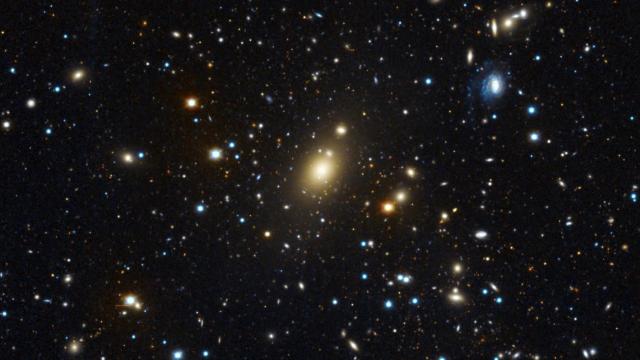Oh my, this recently discovered black hole… well, it’s big.
How big? Among black holes whose masses scientists can directly infer based on the motion of their host galaxies’ stars, it’s the biggest. It’s 40 billion times the mass of the Sun big—that’s around 2.5 per cent the mass of the entire Milky Way galaxy.
It’s 40,000,000,000,000,000,000,000,000,000,000,000,000,000,000 paperclips, if that’s how your mind works.
But is it the biggest black hole possible?
“We actually don’t know how big black holes can be,” Jens Thomas, one of the study’s authors from the Max Planck Institute for Extraterrestrial Physics, told Gizmodo.
The black hole sits in the centre of Holm 15A, the brightest galaxy in the cluster of hundreds galaxies called Abell 85, 700 million light-years away. It’s a bright galaxy with a faint central region—the faintest centre of any known galaxy, evidence that there might be a large black hole present. The researchers studied this galaxy using the Fraunhofer Telescope at the Wendelstein Observatory in Germany as well the multi-unit spectroscopic explorer (MUSE) instrument of the Very Large Telescope in Chile.
[referenced url=” thumb=” title=” excerpt=”]
By watching the motions of the stars, scientists can relate the stellar velocity to the mass of the object that the stars are orbiting—revealing the 40-billion-solar-mass black hole at the centre. This is the largest black hole mass calculated using this method so far, according to the paper published in The Astrophysical Journal. It’s twice as large as the last record holders and 10,000 times more massive than the black hole at the centre of the Milky Way. It’s also four to nine times larger than expected given the amount of stars in the galaxy, according to the paper.
How does such a behemoth form? Well, there’s no rule as to what a black hole’s largest size can be, and the researchers’ simulations seemed to show that if two large galaxies and their large black holes merged in a cluster like Abell 85, it could produce a black hole like the one inside Holm 15A. Indeed, two such nearby galaxies with black holes half the mass of Holm 15A’s exist inside of a cluster of galaxies called the Coma cluster. The faintness of this galaxy’s centre could have come from a merger, which could have flung stars out of the area.
Perhaps, Thomas said, the brightness of a galaxy’s centre compared to its mass will be useful as an indirect measurement for the size of its supermassive black hole. And maybe the motion of the galaxy’s central stars could contain information about the history of a galaxy’s mergers, offering something like a galactic family tree.
The discovery of ultra-heavy black holes is still limited by today’s observational capabilities, since scientists must be able to resolve the motion of objects in the host galaxies. Larger black holes probably reside beyond the realm of today’s telescopes. Maybe a future iteration of the Event Horizon Telescope will produce an actual image of this behemoth.
